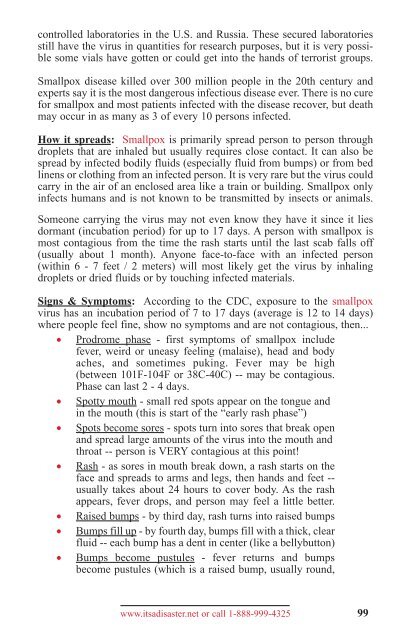disaster 5th 1108_5th ed 2011 - Homeland Security and Emergency ...
disaster 5th 1108_5th ed 2011 - Homeland Security and Emergency ...
disaster 5th 1108_5th ed 2011 - Homeland Security and Emergency ...
You also want an ePaper? Increase the reach of your titles
YUMPU automatically turns print PDFs into web optimized ePapers that Google loves.
controll<strong>ed</strong> laboratories in the U.S. <strong>and</strong> Russia. These secur<strong>ed</strong> laboratories<br />
still have the virus in quantities for research purposes, but it is very possible<br />
some vials have gotten or could get into the h<strong>and</strong>s of terrorist groups.<br />
Smallpox disease kill<strong>ed</strong> over 300 million people in the 20th century <strong>and</strong><br />
experts say it is the most dangerous infectious disease ever. There is no cure<br />
for smallpox <strong>and</strong> most patients infect<strong>ed</strong> with the disease recover, but death<br />
may occur in as many as 3 of every 10 persons infect<strong>ed</strong>.<br />
How it spreads: Smallpox is primarily spread person to person through<br />
droplets that are inhal<strong>ed</strong> but usually requires close contact. It can also be<br />
spread by infect<strong>ed</strong> bodily fluids (especially fluid from bumps) or from b<strong>ed</strong><br />
linens or clothing from an infect<strong>ed</strong> person. It is very rare but the virus could<br />
carry in the air of an enclos<strong>ed</strong> area like a train or building. Smallpox only<br />
infects humans <strong>and</strong> is not known to be transmitt<strong>ed</strong> by insects or animals.<br />
Someone carrying the virus may not even know they have it since it lies<br />
dormant (incubation period) for up to 17 days. A person with smallpox is<br />
most contagious from the time the rash starts until the last scab falls off<br />
(usually about 1 month). Anyone face-to-face with an infect<strong>ed</strong> person<br />
(within 6 - 7 feet / 2 meters) will most likely get the virus by inhaling<br />
droplets or dri<strong>ed</strong> fluids or by touching infect<strong>ed</strong> materials.<br />
Signs & Symptoms: According to the CDC, exposure to the smallpox<br />
virus has an incubation period of 7 to 17 days (average is 12 to 14 days)<br />
where people feel fine, show no symptoms <strong>and</strong> are not contagious, then...<br />
• Prodrome phase - first symptoms of smallpox include<br />
fever, weird or uneasy feeling (malaise), head <strong>and</strong> body<br />
aches, <strong>and</strong> sometimes puking. Fever may be high<br />
(between 101F-104F or 38C-40C) -- may be contagious.<br />
Phase can last 2 - 4 days.<br />
• Spotty mouth - small r<strong>ed</strong> spots appear on the tongue <strong>and</strong><br />
in the mouth (this is start of the “early rash phase”)<br />
• Spots become sores - spots turn into sores that break open<br />
<strong>and</strong> spread large amounts of the virus into the mouth <strong>and</strong><br />
throat -- person is VERY contagious at this point!<br />
• Rash - as sores in mouth break down, a rash starts on the<br />
face <strong>and</strong> spreads to arms <strong>and</strong> legs, then h<strong>and</strong>s <strong>and</strong> feet --<br />
usually takes about 24 hours to cover body. As the rash<br />
appears, fever drops, <strong>and</strong> person may feel a little better.<br />
• Rais<strong>ed</strong> bumps - by third day, rash turns into rais<strong>ed</strong> bumps<br />
• Bumps fill up - by fourth day, bumps fill with a thick, clear<br />
fluid -- each bump has a dent in center (like a bellybutton)<br />
• Bumps become pustules - fever returns <strong>and</strong> bumps<br />
become pustules (which is a rais<strong>ed</strong> bump, usually round,<br />
www.itsa<strong>disaster</strong>.net or call 1-888-999-4325<br />
99





